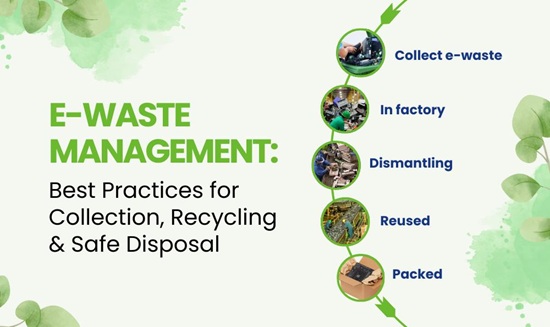Electronic waste or E-Waste refers to discarded electrical and electronic equipment that are no longer usable — such as mobile phones, computers, televisions, refrigerators, etc. These devices contain valuable metals (gold, silver, copper) as well as hazardous materials (lead, mercury, cadmium, beryllium). Therefore, proper e-waste management is not only an environmental necessity but also an economic opportunity.

Current Scenario in India
- India is the third-largest e-waste producer in the world — after China and the United States.
- According to the Global E-Waste Monitor 2024, India generated around 1.8 million tonnes (18 lakh tonnes) of e-waste in 2023–24.
- Only 40–45% of the e-waste is formally collected and recycled.
- More than 70% of the remaining waste is handled unsafely by the informal sector.
- Major e-waste generating states: Maharashtra, Tamil Nadu, Uttar Pradesh, Delhi, Gujarat, Karnataka, and West Bengal.
Causes of Rising E-Waste
- Rapid Technological Change – Devices become obsolete quickly.
- Consumerism – Continuous demand for new models.
- Expansion of E-commerce and Digitalization.
- Influx of Cheap Electronic Goods.
- Lack of Awareness and Policy Compliance.
Impacts of E-Waste
|
Sector
|
Impact
|
|
Environmental
|
Burning or melting of e-waste causes air, water, and soil pollution. Toxic elements seep into groundwater causing long-term ecological damage.
|
|
Health
|
Exposure to lead and mercury affects the brain, nervous system, lungs, and kidneys — especially harmful for children and pregnant women.
|
|
Economic
|
Valuable metals (gold, silver, palladium) are lost — worth over ₹7000 crore annually.
|
|
Social
|
Informal workers handle toxic materials without safety gear, leading to severe health hazards.
|
Policy and Legal Framework
(a) E-Waste (Management) Rules, 2011
- India’s first comprehensive legal framework.
- Introduced the concept of Extended Producer Responsibility (EPR).
(b) Amended Rules, 2016 & 2018
- Clearly defined responsibilities of producers, collectors, and recyclers.
- Established Producer Responsibility Organisations (PROs).
- Set collection targets — 30% in the first year, up to 70% by the fifth year.
(c) E-Waste (Management) Rules, 2022
- Launched EPR Registration Portal (CPCB) for better tracking and transparency.
- Introduced Recycling Certificates and Credit Trading System.
- Emphasized the “Reduce–Reuse–Recycle–Recover” principle.
Institutional Mechanism
- Central Pollution Control Board (CPCB): National-level monitoring and policy formulation.
- State Pollution Control Boards (SPCBs): Licensing, inspection, and enforcement.
- EPR Portal (2022): Unified digital platform for data transparency and reporting.
- Recycling Units & Collection Centres: Around 450 authorized facilities across India (as of 2024).
Major Government Initiatives
- Digital India Mission – Promotes responsible disposal of digital devices along with e-governance.
- Swachh Digital Bharat Abhiyan – Public awareness campaign on e-waste.
- Green E-Waste Management Programme – Expansion of formal recycling infrastructure.
- Startup Support – Encouraging MSMEs and startups in e-waste recycling technologies.
- Public–Private Partnerships (PPP) – Collaboration between PROs and municipal bodies.
Key Challenges
- Dominance of the informal sector — unsafe recycling without protection.
- Lack of data transparency on actual waste quantities.
- Limited technical capacity — few modern recycling plants.
- Low public awareness among citizens and industries.
- Illegal imports of foreign e-waste into India.
- Slow implementation of circular economy practices.
Way Forward
|
Area
|
Strategy
|
|
Policy
|
Strengthen enforcement of EPR rules and digital monitoring.
|
|
Technology
|
Promote eco-friendly recycling technologies (e.g., hydrometallurgical processes).
|
|
Infrastructure
|
Establish “E-waste Collection Centres” in every district.
|
|
Social
|
Integrate and train informal workers within the formal sector.
|
|
Awareness
|
Launch national campaigns like “Recycle Your Device.”
|
|
International Cooperation
|
Adhere to Basel Convention guidelines for cross-border waste control.
|
Conclusion
E-waste is not merely a pollution issue but also a potential resource. By prioritizing circular economy, EPR compliance, and scientific recycling, India can reduce environmental risks and move toward a Green Economy. Sustainable e-waste management strengthens India’s commitment to SDG-12 (Responsible Consumption & Production) and SDG-13 (Climate Action).
“E-waste is not a problem to be buried, but a resource to be recovered.”



